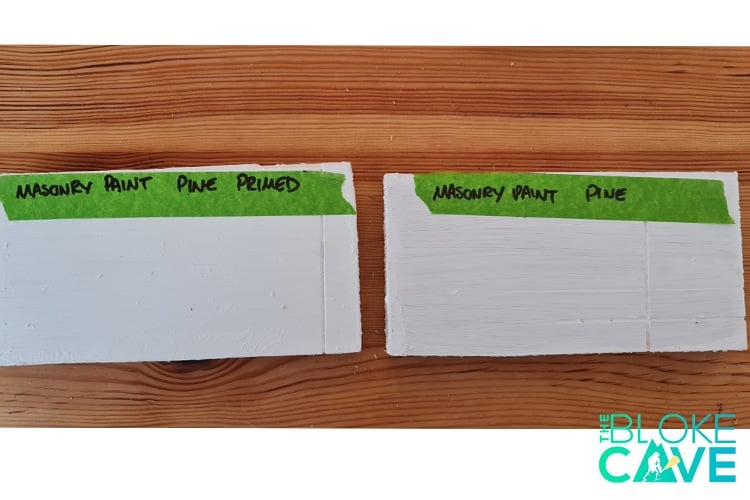We have answered this question once and for all, and to make it as thorough as possible we grabbed five different types of wood along with four different possible wood paints. We painted our wood samples with masonry paint, exterior gloss, fence paint and finally allcoat. Let’s find out how the masonry paint got on in this mega test!
Can you use masonry paint on wood?
So below are all of the different squares of paints I will be testing. We will test each paint, both with a primed piece of wood, and an unprimed piece to see how much of a difference priming the wood first makes.
I applied two coats of paint to each sample, so the primed pieces ended up with three coats (1 coat of primer and two of the paint of choice).

Painting the wood
The masonry paint went onto the wood absolutely fine. It felt very similar to painting with the exterior gloss. The coverage was good but not excellent, without primer it would take three coats of the masonry paint to get really good coverage. Dry time was relatively quick so if you are painting a large area like say a shed you wouldn’t have to wait long between coats at all, the paint was dry enough to apply another coat within two hours.
Did it adhere?Now all the pieces of wood had been left to dry overnight after their final coat it is time to test how well the paint has adhered to the surface.
I grabbed a rough piece of timber and scratched it across the surface of the painted pieces to see if any of the paint came away. Let’s see how they all got on.Masonry Paint on Plywood – Tested
Above we have the results for Masonry paint on Plywood. As you can see the paint has covered well, with the unprimed piece looking like it probably needs one more coat(which would be its third) to finish it fully.
Now for the same test but on a piece of pine. As you can see on the right-hand side of the image the unprimed piece of wood again looks like it could do with an additional coat of paint.Masonry Paint on Pine – Tested


Now onto MDF, MDF can be a little tricky for some paints as it has a really absorbent surface that can suck up your paint so it will be interesting to see how the masonry paint got on, especially on the unprimed piece.

So we move on to fencing timber. This rough sawn timber is commonly used in fencing and could be a great application for masonry paint. After all, we commonly paint fences not only for the nicer appearance but also to prolong the life of the wood, lets see how the paint got on.
The masonry paint has actually covered really well here in just two coats, better than a lot of the other wood types.

So we have reached the final wood type, chipboard. Chipboard is commonly used as flooring in newer houses and in lofts. But can you paint it with masonry paint?
The paint went on really well again and covered the wood well. The non primed sample probably requires another coat to be perfect.
Outdoor Test
So for the next section of our test, I will move all these samples outside into the elements. I will check on them periodically and update you on how they have survived, so keep checking back!They will go up against the more commonly used exterior wood paints also painted at the same time, so we will see how masonry paint stacks up against:
Exterior Wood Gloss
Fencing Paint
Allcoat
6 Months Outdoors
So the wood samples have been sat outside now, fully exposed to the elements, for around six months. I think it’s time to take a look at them all and give you guys an update.

So here are all the samples, looking pretty good. But let’s have a closer look at them all one by one as there are a few interesting things going on.
Pine
The pine has held up really well so far and there is no visible difference between the primed and unprimed pine.
So far so good, it looks like masonry paint will protect pine that is left outside.
MDF

Again, very much like before. The MDF has held up brilliantly, both the primed and un-primed still looking as good as new.
Plywood

Another one that is holding up perfectly and with no difference that I can see between the two samples.
Fencing Timber
Like all of the other woods so far the masonry paint has done a great job of protecting this fencing timber.
Chipboard

Now we finally have something to talk about. The chipboard has swelled quite a bit and gone lumpy. This obviously means water has been getting in somewhere.
You can also clearly see that the primed one has fared a lot better so far. So just adding that extra layer of paint has helped to seal it. Although it has still gone a little lump, but nowhere near as bad as the sample without primer.
Learn More About Masonry Paint
This article is part of our masonry paint section, learn more about masonry paint with the following articles:



Can you use masonry paint on wood?